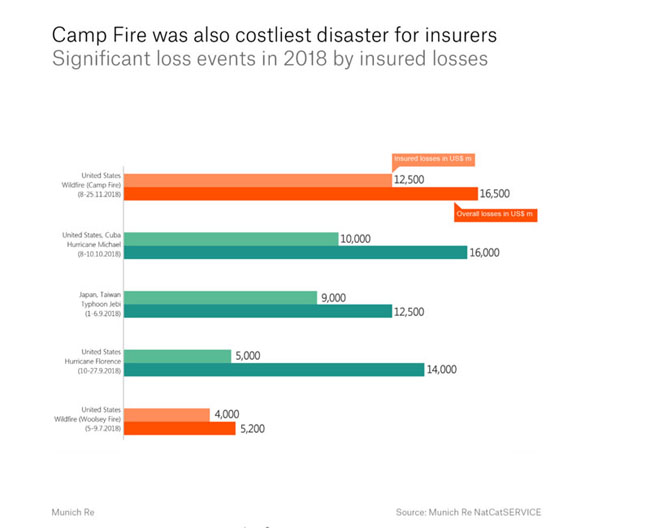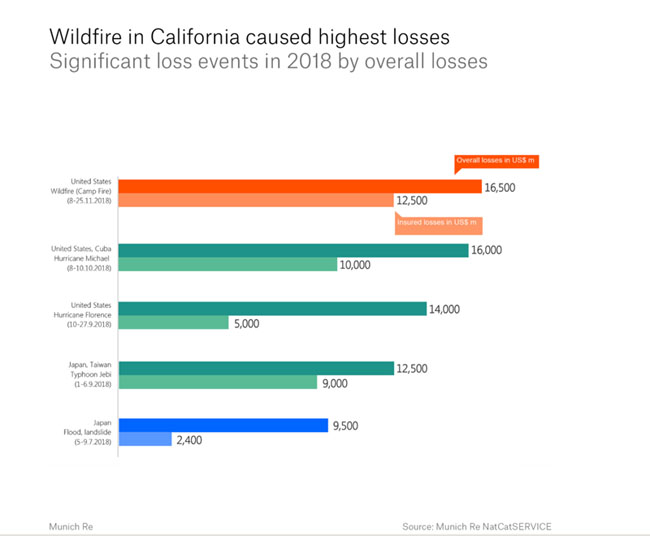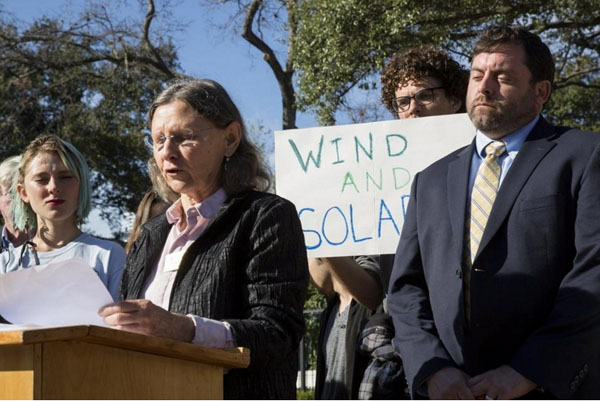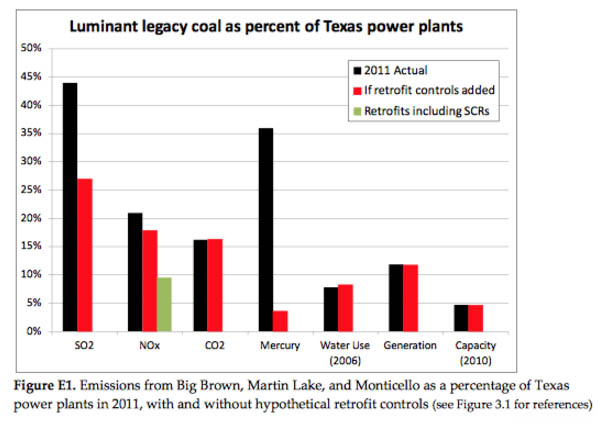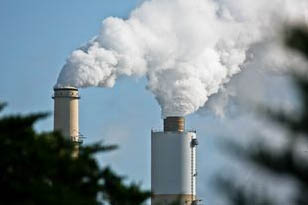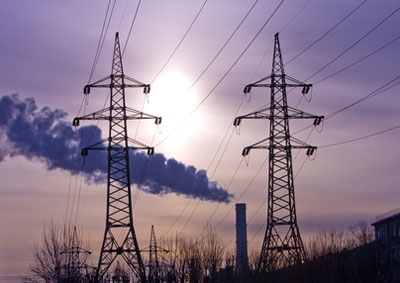07/30/2014
Gail Reitenbach
POWER Magazine
Interest in the Environmental Protection Agency’s (EPA’s) carbon pollution standards for existing power plants—the "Clean Power Plan," proposed under the authority of the Clean Air Act Section 111(d)—was so high that the agency had to add double the days and double the rooms at all four locations this week. At all locations, power industry speakers were in the minority—not because they were outnumbered, but because they simply didn’t choose to participate. But that doesn’t mean the hearings lacked value or interest. Testimony from a former coal miner, coal industry groups, members of the military, an Olympic medal holder, a climate scientist, environmental groups, and individual citizens demonstrated the range of views on the proposal and the health, climate, and economic stakes.
The hearings, scheduled for Denver, Atlanta, Pittsburgh, and Washington, D.C., were originally scheduled to be held on a single day at each location. A couple of weeks after the schedule was announced, each site added a day, EPA Media Affairs Officer Lisa McClain Vanderpool told POWER on July 28. All locations also added a second hearing room. More than 200 people were registered to speak on both July 29 and 30 in Denver.
Advocacy groups both for and against the proposed standards, from the Sierra Club to Americans for Prosperity, held rallies and press events at other locations on hearing days, where they spoke largely to those who share their views. Inside the hearing rooms, EPA staff heard a mix of views—and not just from the extremes. (Note that the comments addressed in this story reflect just those heard in one of the two rooms on the first day of the hearing.)
Most attendees at the Denver hearing were from Colorado, but they also came from several other states, including Texas, New Mexico, Wyoming, California, Oregon, Missouri, Kentucky, and New York.
Although the speaker lineup for the Denver hearings in the EPA’s new Region 8 offices changed over the 24 hours prior to and during the sessions (due to no-shows and substitutions), the preliminary posting of speakers at all locations showed that power industry stakeholders were a small minority of those registered to speak.
Power Industry Largely Silent
Among the few power generating company representatives who did show up was Michael Hutcheson, an environmental engineer for Ameren, which serves Missouri and Illinois. Ameren, he said in his five-minute comments, believes the rule is legally and technically flawed and will cause higher customer costs and economic damage to the country. Hutcheson described Ameren’s efforts to reduce emissions, including installing scrubbers and improving efficiency.
"We have made progress in reducing our carbon footprint," Hutcheson said, and the company is adding more renewables, combined cycle capacity, energy efficiency, and retiring coal "at the end of its useful life," and adding plans for more nuclear. Ameren can achieve a 30% reduction "over a slightly longer time frame" with less cost than the EPA’s plan, he said. Hutcheson also suggested the EPA should eliminate the "aggressive interim goals" that begin in 2020 and replace them with a plan for states to come up with a "glide path" for those goals. States should have flexibility to extend the final goal past 2030 for "reliability concerns and rate shock." Ameren believes it could meet the goals by 2035.
 Michael Hutcheson, Ameren. Source: POWER/Gail Reitenbach
Michael Hutcheson, Ameren. Source: POWER/Gail ReitenbachLater in the day, I spoke with Hutcheson about the scarcity of other generating companies at the hearings. He said that after the second day was added, he was told he couldn’t speak because there were no open slots, but he traveled to Denver anyhow and got a 9:45 slot. Ameren also sent speakers to the D.C. and Pittsburgh hearings and is submitting written comments.
"We’re still looking at the rule," he said. Other power companies are likely also spending time with lawyers and other advisors parsing the details of the proposal before going on the record with comments. Other generators Ameren has talked to are submitting written comments, so they saw no reason to make oral comments, Hutcheson said.
Co-ops and Munis Particularly Concerned
The one industry cluster that was most visible at the Denver hearing was cooperatives and municipal utilities, which are concerned that their members and customers will be exposed to rate shock should the proposed rule be finalized.
Troy DeJoode, with the Iowa Association of Municipal Utilities, said their main concern is one of complexity and timelines. "I’m not here to debate the rules," he said. "It’s simply a matter of practicality," noting that he appreciates "the flexibility that EPA has provided the states." He said his group would provide more details in written comments on rate impacts, stranded costs, and other issues.
Rick Gordon, representing Tri-state Generation and Transmission Association, which provides power to 44 electric co-ops, said those co-ops have some of the poorest consumers. He suggested that farmers trying to irrigate their fields and mothers trying to raise their children will pay the price of the regulation. He expressed concern that there was "no consideration of the cooperative model" in the proposed rule, because co-ops cannot recover costs, as regulated utilities can. Because of the former ban on natural gas generation when Tri-State was expanding, co-ops don’t have much gas capacity in their portfolios. He also commented that "EPA may not have the legal authority" to propose the plan, which "expands EPA authority." As did others in the power industry, he called for a "more reasonable timeline."
Dan Hodges of Colorado Springs Utilities, a municipal utility that owns and operates coal, gas, and hydro plants, shared several concerns. Among them, he said that building blocks 3 and 4 and maybe 2 are not necessarily supported by the law. He also feels the proposal timeline is very rushed and puts a burden on utilities to come up with a budget and plan. He shared concern about "errors in the plan" like nameplate capacity (which the EPA used) versus actual certified operating capacity. The push toward gas generation also poses challenges. One gas power plant uses about as much gas as all the gas used in Colorado Springs now, he said, so there are implications for gas demand. He asked the EPA to consider a less-stringent interim goal and said he was concerned residents will get hit by gas increases on both home heating and electricity bills if there are changes in the gas market.
Not all co-ops are against the plan. Megan Gillman, vice president of the Board of Directors of Holy Cross Energy, an electric co-op for the Vail and Aspen area, explained that her utility is moving toward lower-intensity energy. Its 20% renewables by 2015 goal has already been met. She recognizes that power generation resources vary by region, but "climate change is not a local issue." She asked the EPA to consider combustion of vented methane. Holy Cross has partnered with an active coal mine in western Colorado on such a project, but they are concerned that it will count as an increase in carbon emissions for them, not a decrease. She asked the EPA to enable innovative approaches and to consider lifecycle carbon emissions for biomass projects involving woody biomass (of which there is a lot, due to pine beetle kill in the state). She also asked that the EPA ensure accounting for early action.
Tom Smith, director of the nonprofit Public Citizen’s Texas office, said he is also a member of an electric co-op. "The cost of inaction is far too high," he said, citing the costs of crop losses and failures due to drought and wildfires; health impacts, including diseases coming back that had previously been eliminated; the cost of asthma going up; and escalating insurance costs for flood and fire. "No state has the ability to benefit more [from the rules] … than Texas," he said, because of its large role in renewables and natural gas. About 120,000 people are employed in the renewable industry in Texas, he said, and only about 23,000 in the coal industry—"and we mine and burn a lot of coal in Texas," he added. A public utility commissioner had asked him to suggest going back to 2005 for the baseline. He said he thinks co-ops need a separate subsection for their own implementation plans.
Coal Industry and Workers Not Necessarily Aligned
One of the starkest contrasts of the day came right at the beginning. EPA staff indicated that speakers were scheduled according to when they registered, though no-shows and substitutions altered that schedule throughout the hearing. Nevertheless, back-to-back five-minute comments by John S. Kinkaid, Robert Emery, and Stanley Sturgill essentially marked the opposing sides.
Moffatt County (Colorado) Commissioner Kinkaid was one of the rare few who invoked the EPA’s "war on coal" in his remarks and said it would affect his county’s economy. "Coal lifts people out of poverty," he said. The $85,000/year jobs provided by coal mining can’t be replaced by job retraining, he argued. Kinkaid also spoke out against "environmental extremists" and argued that CO2 is not a pollutant.
Emery, who moved to Colorado from North Carolina to escape the negative effects of coal-fired power plant pollution and whose comments included data from reinsurance giant Munich RE regarding the insurance aspects of climate change, said the fossil energy industry could have been a leader in transitioning the energy economy but wasn’t. He and others after him also noted the enormous costs of responding to recent extreme wildfires and flooding in Colorado.
Emery was followed by Sturgill, a retired coal miner who traveled from eastern Kentucky to speak. Sturgill said he knows coal miners need jobs, but maintained that they can be retrained. Sturgill, who said he lives downwind from 56 coal-fired units in Kentucky, has black lung, COPD, and other respiratory ailments. He said he was speaking for the health of the citizens of Kentucky and commented that the proposed rule is "a mere lean" in the right direction. The EPA, he said, is giving states and coal plants too many breaks. "EPA," he concluded, "we’re dying—literally dying for you to help us."
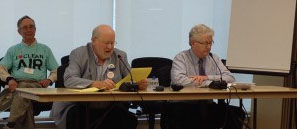 Stanley Sturgill, retired coal miner (speaking). Source: POWER/Gail Reitenbach
Stanley Sturgill, retired coal miner (speaking). Source: POWER/Gail ReitenbachGreg Schaefer, vice president of external affairs for Arch Coal’s western operations, spoke a bit later. He is nearing retirement and wonders about the industry’s future. He said he’s concerned that many are trying to shut down the industry without regard for jobs and incomes. Mining operations in Wyoming pay up to $32.90 an hour, he said. His son is a haul truck driver, and other family members are also involved in the coal industry. "EPA is asking a lot from families like mine," he said, especially as the rule won’t do much for climate change, as it’s a global problem. Schaefer also talked about how the coal industry supports Wyoming schools and asked the EPA to withdraw the proposal.
Jonathan Downing, with the Wyoming Mining Association, a statewide trade association for 39 members mining coal, bentonite, and other materials, questioned the EPA’s legal authority to regulate greenhouse gas emissions from existing power plants and warned of overreliance on natural gas.
Health, Environmental, and Agricultural Concerns
Individual speakers and those representing groups addressed health issues related to "traditional" coal plant emissions as well as health conditions that are exacerbated by the effects of climate change—from increased heat to increased pests and pollens.
Some spoke purely about generalized concern for the future of children and grandchildren. Others included data in their comments about environmental and health impacts of climate change that they hoped to see mitigated by the EPA’s proposed rule.
Speakers affiliated with the Sierra Club were among the most visible, thanks to their aqua-colored tee shirts bearing the message "I [heart] Clean Air." In the week leading up to the hearing, the Sierra Club made a "high five-figure investment" in a radio campaign designed to get folks out to the hearings. Several speakers were registered to speak at all hearings, but in Denver, there appeared to be additional members in attendance as well.
James Hughes, the first Sierra Club speaker, argued that "The EPA is a mouse trying to put out the fire" in light of the greater power held by the fossil fuel industry.
Bill Corcoran, western regional director of Sierra Club’s Beyond Coal campaign, spoke against the "useful life of coal plants" approach and said the climate can’t wait for the end of that useful life. He urged 35% to 40% emissions reductions from coal plants rather than the proposed 30%. He doesn’t want to see incentives for natural gas and nuclear and said wind and solar are growing in capacity. He argued that the EPA underestimated renewable energy growth opportunities.
Jaime Travis, "head mom" of Colorado Moms Know Best, thanked the EPA. She commented that Coloradans are protective of the outdoors. One-third of hospital visits for children in Colorado are due to lung conditions, she said. "We all have a moral obligation to protect our kids."
Ronnie Citron-Fink, a parent and teacher representing Moms Clean Air Force, traveled from New York to share concern about children with asthma. Climate change is making conditions worse for respiratory conditions, she said.
Cindy Liverance, vice president of programs for the American Lung Association in Denver, is asthmatic and has children with respiratory issues. "We need the Clean Power Plan to protect public health," she told EPA staff. She has to watch outdoor levels of air pollution before engaging in outdoor activities and noted that kids with asthma can’t always play outside at school. When 85 kids with respiratory conditions at "Champ Camp" were asked, they all said they want clean air and "don’t understand why adults keep it dirty."
Dr. Patrick O’Herron, a practicing trauma and acute care surgeon from Oregon, said he was "speaking for thousands" of health care practitioners. He commented on issues of food and water security as well as air- and water-borne diseases. He asked if the plan is the best the EPA can do to protect the health of citizens.
Steve Szbao, a farmer from Longmont, Colo., talked about his personal experience of seeing the benefits of the acid rain program and said he’s worried about weather effects on crop production in the future.
Mark Fix, Montana rancher and irrigator, thanked the EPA for the rule and shared his experiences with "climate weirding." He is a wildfire survivor and also saw a tornado with over 90 mph winds hit his farm last year. He is still cleaning up downed cottonwoods from that event. Fix lost 10% of his heifer calves from sickness and a long winter and detailed the impacts on cattle of unusual freezing and flooding. Those in agriculture have to deal with the weather every day, he said, so "it’s an economic and environmental imperative" for the rule. Fix is a co-op member and said a focus on coal has put his supplier into bankruptcy.
Though attendees were cautioned not to jeer or cheer, out of respect for all speakers and to keep the hearing moving, there was one instance of laughter. Eric Larsen is a polar explorer—“a job you’ve probably never heard about”—with a 72-day no-shower record (which elicited the laughter). “I’m pretty much average in every way,” he claimed, before explaining that he was just back from his “Last North” expedition. He has completed more polar expeditions than any other American in history and goes because “they may not be there” in the future. His expeditions are designed to “connect people to the last great frozen places” and to catalog places for the record. “We are all average people” but have the ability to do amazing things, like reducing carbon emissions, he concluded.
 Eric Larsen, polar explorer. Source: POWER/Gail Reitenbach
Eric Larsen, polar explorer. Source: POWER/Gail ReitenbachFirefighters Concerned
John Lauer was one of two firefighters on Tuesday who spoke in support of the proposed rule. Lauer, a wildland firefighter, cited studies that point to increasing wildfire risk. Though wildfire is natural, a “natural” wildfire moves slowly, he said, but today we have “super fires” moving at an explosive rate, destroying the soil and everything in its path. Lauer fought the Gila Fire, the largest in New Mexico history. He spoke of the cost of fires, including property and human life loss. Proposed regulations reduce the odds of conditions that lead to these fires, he commented. He also spoke well of those in the coal industry who “should be fully supported” in a transition to a new future.
 John Lauer, wildland firefighter. Source: POWER/Gail Reitenbach
John Lauer, wildland firefighter. Source: POWER/Gail Reitenbach
The Military Perspective
Hal Bidlack, speaking as an individual, is a former member of the U.S. Air Force, holds a PhD from Michigan, worked at the White House on energy security issues, and taught at the Air Force Academy, among other professional accomplishments. “We shouldn’t wait to address looming threats,” he said. He believes too many American leaders have waited too long to address the climate change threat. The military, however, gets it. There are three challenges for Pentagon, he outlined:
- Climate change is a threat multiplier. It will cause resources to become more scarce. Extreme weather events have already required military response, including to the 2013 typhoon Haiyan in the Philippines.
- Climate change will affect homeland security. The effects of climate change affect Colorado, not just polar regions, he noted. The Waldo Canyon fire came within a mile of his home. No single event is proof of climate change, he acknowledged, but the accumulation of them is.
- Climate change presents a challenge to military bases around the world. Bidlack mentioned Camp Pendleton evacuations due to extreme weather.
ilitary planners customarily operate with incomplete knowledge, he observed. After citing Dick Cheney’s "1% doctrine" (if there’s even a 1% chance of a terrorist act, that justifies action), he observed that too many leaders dismiss overwhelming science showing that climate change is real.
Job Losses Feared—From the Rule and From Climate Change
The arguments about anticipated job losses and electricity cost increases resulting from the proposed standards are familiar and were addressed by coal industry speakers. But speakers representing other groups and industries argued that unless coal generation is curtailed, many other industries will experience catastrophic economic losses. The ski industry was among those representing that side of the issue.
Kaylin Richardson, a pro skier and two-time Olympian, said that over the last 20 years she had been observing climate change and not realizing it. She has trained on glaciers in France and Austria that are disappearing. At the 2010 Winter Olympic games in Vancouver, it wouldn’t get to freezing, which made for scary conditions for competitors. Last year, while in Norway to film a ski movie for Warren Miller Entertainment, there was no bitter cold—above the Arctic Circle. Another year, it rained in Norway in February, she said. And in Colorado, the spring melt season starts two months earlier than historically. She said she’s concerned not just about the loss of great skiing conditions but about business and job losses that result from shorter ski seasons.
 Kaylin Richardson, professional skier. Source: POWER/Gail Reitenbach
Kaylin Richardson, professional skier. Source: POWER/Gail ReitenbachLiz Mcintyre, a three-time winter Olympian and member of the National Ski Hall of Fame, among other kudos, lives in Grand County, Colo., and purchases power from a co-op. She said the National Rural Electric Cooperative Association is shutting out the voices of many on this issue. "A well-conceived plan is necessary to achieve desired results," she argued. She commented that she had skied on a glacier in France that has now disappeared. To industry, she asked, "what have you been doing for the last 40 years? Is keeping the power on enough?"
 Liz Mcintyre, professional skier. Source: POWER/Gail Reitenbach
Liz Mcintyre, professional skier. Source: POWER/Gail ReitenbachCatharine McCormick, of the Natural Resources Defense Council, focused on the experience of Iowa, the leader in wind generation. Mid-America Energy will invest even more in wind in the state to increase wind to 40% of its portfolio, she said. Iowa also has some of the cheapest rates in the country and has attracted Facebook and other tech company data centers. She called for more energy efficiency in the plan, which creates jobs in installation and retrofits.
Chris Votoupal, deputy director of Colorado Cleantech Association, said that group’s members are involved in using all forms of energy and are in support of the proposed regulations. The association has technologies to help assist in reducing greenhouse gas emissions in all the areas, from gas technology to demand side management, he said. Regarding the cost impacts of the policy, he (like many others) argued that the cost of coal generation doesn’t take into account health effects of coal-fired generation or costs of drought, fire, and floods. The same arguments about cost were raised with previous regulations, he noted, but the higher rates did not materialize.
Moral Oral Arguments
Various religious groups were represented at all four hearing locations.
In Denver, Jim White introduced himself as "a person of science and faith" who is involved with the Lutheran advocacy ministry of the Evangelical Lutheran Church in America. He’s also a full professor at the University of Colorado and has studied ice cores, is a highly cited author (the top half of 1%, he said), and a climate scientist. "At its core, climate change is a moral issue," he commented, one that creates an "intergenerational inequity," as future generations will suffer the consequences. Climate change also has a disproportional impact on poorer people, he observed, before quoting Christ: "Whatever you did not do for the least of these, you did not do for me." The proposed plan won’t resolve all the problems, but is a start, he concluded.

Jim White, climate scientist. Source: POWER/Gail Reitenbach
A Colorado Focus on Climate Change Impacts and Generation Mix Shift
Matt Jones, Colorado state senator, spoke about the 169 houses lost in Colorado’s 2010 Fourmile Fire in Boulder County, which he fought. That was only one of several recent Colorado wildfires, he noted. He emphasized that it’s not just a Colorado issue. Firefighters are not climate change deniers, he said, citing a 60 Minutes episode on wildfires.
Last year, Jones’ district also experienced an unprecedented flood that damaged 28,000 dwellings and resulted in $3.36 billion in damage. The county is considering a sales tax increase to pay for some of the damage. Jones said it will be cheaper to act now on moving to cleaner power sources than to continue responding to the effects of climate change.
But Colorado isn’t alone in experiencing extreme weather events. Karen Hadden, from Texas, asked the EPA to strengthen the rule. She commented on heat extremes in Texas as well as wildfires and floods in Austin—including an unexpected flash flood that was the worst since the 1800s. Many power co-ops, she noted, are opponents of the proposed rule but could benefit from the rule, she argued. She asked that renewable credits be allowed to be sold across state borders and for nuclear power incentives to be cut because nuclear power is "not clean and not affordable."
Jerry Tinianow, Denver’s chief sustainability officer, said the city wants to know if it will get credit for what it’s already done and expects the rule will provide an economic benefit to the Denver region.
Max Tyler, chairman of the House Transportation and Energy Committee for Colorado, said that because of what the state has done in the past 10 years (mostly in terms of increasing renewable generation), it is well on the way to meeting the EPA goals. He asked the EPA to hold to the 2012 baseline “because the bar is too low at the 30%.” He believes the private sector “can accomplish this with little effect.” In reference to John Kincaid’s comments about Western Slope generation, he noted that the skies may be clear in Craig, Colo., but its coal plant pumps out more carbon pollution than any other stationary source in Colorado. He argued that maximizing profit is a legitimate mission for coal companies and utilities but not for the EPA, and concluded that Colorado’s shift to a cleaner portfolio has been much more cost-effective than anticipated.
Renewables Promoted as Coal Alternative
Several speakers commented that renewables had the ability to supplant coal for power generation. In addition to various environmental groups, a solar industry representative, and individuals, business and civic groups spoke in favor of renewables.
Among them was a representative of the employee-owned New Belgium Brewing Co., a Colorado company that has solar photovoltaic panels on its roofs and that taxes itself for coal power used. It’s also working with the city of Fort Collins on demand response and other energy efficiency measures. “Regulation is required to create appropriate market signals” for cleaner power, the speaker said, noting that Fort Collins was the first city in the state to pass a renewable portfolio standard.
Kyla Maki, with Montana Environmental Information Center in Helena, called for increasing Montana’s emissions reduction targets based on the state’s renewable energy potential. She said Montana’s emission reduction target is the second lowest proposed by the EPA’s plan but thinks the state’s wind energy potential, which is second in the country, should be factored in.
Among the individuals speaking in favor of the proposed plan was Andrew Lane, who said his Army unit won’t let him wear his uniform to the hearing, but he brought it with him. Lane, who is also a graduate student at Arizona State University, said those in support of this plan are not “extremists” and noted that the U.S. military is going green. By 2016, the Navy will use 50% renewable fuels. “For anyone who denies climate science, I don’t know where you are,” he said.

Andrew Lane, graduate student and Army. Source: POWER/Gail Reitenbach
Carbon Tax Advocates
Several speakers encouraged the EPA to make a carbon tax at the state level an option in its final rule. They noted that economists, politicians, and scientists have concurred that a carbon tax is the best method of reducing emissions, so they are surprised it wasn’t included in the plan. Some noted that anything labeled a tax seems to have an impossible time of passage at the federal level, but there seems to be greater potential for a carbon tax if handled at the state level.
Catherine Caruthers of Environmental Tax Reform U.S. was among those who cited a report by Regional Economic Modeling Inc. (REMI) that suggests a carbon tax may be a faster, cheaper way to get to the EPA’s goals.
Susan Seacord of Sierra Club said a “well-designed carbon tax” would protect families from rising costs and actually add jobs if monies are returned to the public, citing the REMI study as well as British Columbia’s experience with a carbon tax.
The Public Was Heard at Public Hearings
At the start of Tuesday’s hearings, Sean McGrath, regional administrator for EPA Region 8, noted that more than 300,000 comments on the proposed carbon pollution standard had been received to date. “There are no special comments or special groups,” McGrath said, reminding attendees that comments can also be made online until October 16. The EPA values the diversity of opinion, he said. “Even if you don’t agree with the speaker, please respect them.”
Though various sources predicted that the hearings would be contentious, heated, and require a passport to gain entry, in my eight hours at the Denver hearing, I didn’t hear any cheering or jeering in the building, and I didn’t need a passport to enter.
—Gail Reitenbach, PhD, editor (@GailReit, @POWERmagazine)
Fair Use Notice
This document contains copyrighted material whose use has not been specifically authorized by the copyright owner. SEED Coalition is making this article available in our efforts to advance understanding of ecological sustainability, human rights, economic democracy and social justice issues. We believe that this constitutes a "fair use" of the copyrighted material as provided for in section 107 of the US Copyright Law. If you wish to use this copyrighted material for purposes of your own that go beyond "fair use", you must obtain permission from the copyright owner.

